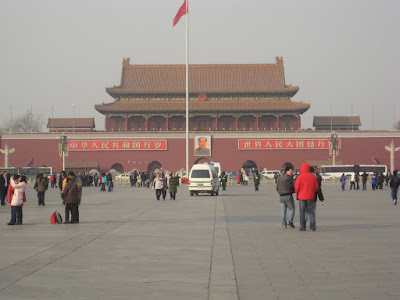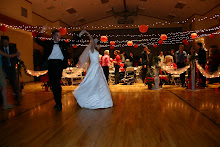A view of Tiananmen Gate to the Forbidden City from Tiananmen Square 
With the relatively recent emergence of the Forbidden City in international cinema, people around the world get an idea of its majesty and magnitude. In my opinion, though, you can only conceptualize its immensity by visiting it yourself, regardless of how big the "big screen" is. The massive complex marks the center of
These two lions are often found guarding important doorways around China. One lion (female) holds a lion cub under its paw, symbolizing its influence and responsibility to properly care for its posterity. The other lion (male) has a sphere under its paw symbolizing its power over the world.
Here, Ellie frantically searches the Forbidden City for a picture perfect family who doesn't dump her on the grandparents when they come to visit:

It is easy to get lost in its numerous corridors, gardens, and rooms (it is said to have 9,999 rooms when the complex was first constructed). As the imperial palace, it contains two massive throne rooms for two different dynasties: the Ming and Qing. From multiple stories I've heard, it seems that the throne rooms were mostly for show; when foreign ambassadors visited the palace, the sun illuminated the emperor in his golden splendor on the throne, perfectly solidifying his dynastic power in the visitors' minds. The real power (at least later in the Qing) was held in the back rooms of the city where negotiations and state dealings were determined. In the room seen below, the notorious Empress Dowager manipulated the emperor as she sat behind the curtain and told him what to say.


CHINA MYTHBUSTERS: The Forbidden City was forbidden to pretty much everyone except royalty and eunuchs. FACT! They were among the few who were allowed in!
If you thought you could visit this part of China inconspicuously, think again. The grounds are full of uniformed guards and security protecting this museum, and even more officers in plain clothes. Tiananmen Square (across the street) never lacks in 20-seater-paddywagons ready to book scores of undesirables at any given moment. Also, the surrounding streets are loaded with "hidden" cameras that reveal Big Brother's predictable hiding places around the area, about every 25 feet or so on alternating sides of the road. (The privacy issue was especially evident in our walk to the White Pagoda between The Forbidden City and Zhongnanhai- the Party's headquarters and highest official's living residences).
To the Northwest of the Forbidden City is a picturesque park: Beihai Gongyuan with its famous White Pagoda. It seemed like we walked forever to get there from the Tiananmen West subway stop, but it was probably because we had lost the spring in our step from our morning excursion.
Saturday, March 01, 2008
Ma and Pa Larsen Visit China: Part 6- Forbidden City/ White Pagoda
Posted by Kyle at 5:40 AM
Subscribe to:
Post Comments (Atom)


















1 comments:
Is that from Hairspray? I just saw it on your recommendation and loved it!
Post a Comment